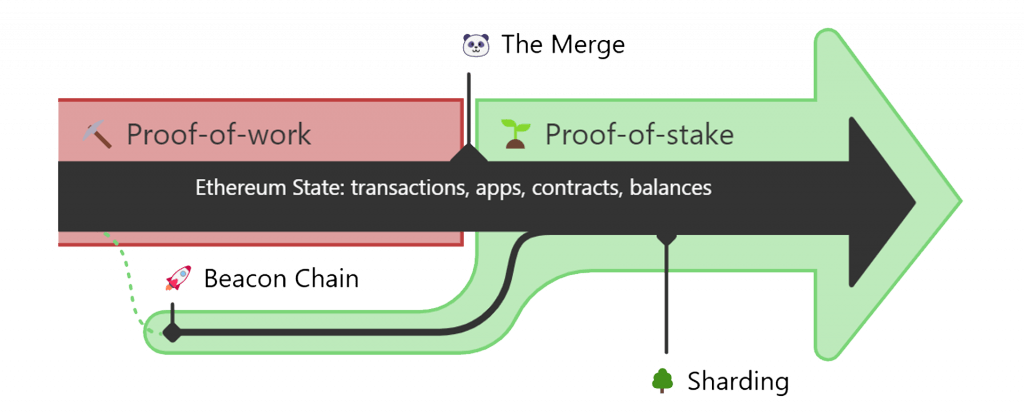Ethereum foundation is all set to execute its most awaited and crucial upgrade, “Merge”, in a few days. After more than eight years of delay, we finally have the merge around the corner. The entire crypto community is intrigued by the latest upcoming upgrade, as it will bring significant changes to the ecosystem. Being one of the largest blockchains harbouring the decentralized platforms, Defi and Dapps, Ethereum works as a digital oil for the decentralized world. The importance of the Ethereum blockchain is unparalleled for the crypto community, and hence the upgrade which will change how Ethereum works is worth understanding in detail. To have an overview of the Merge and its potential benefits for the crypto community, we would first like to make you familiar with the Ethereum upgrades roadmap.
Ethereum upgrades roadmap:
In order to make Ethereum more secure, sustainable, and scalable, the foundation prepared a roadmap for executing upgrades in the following order:
- The Beacon Chain: Rolled out on 1 Dec 2020
- The Merge: Expected to happen in Sept 2022
- The Sharding: Expected to roll out in 2023- 24
These upgrades are planned in such a way that the former upgrade will prepare the stage for the latter one. For example, before rolling out the merge, the Beacon chain was made live to support the upcoming Merge upgrade. Before getting into the details of the merge, let’s have an overview of the Beacon chain.
What is the Beacon chain?
It is a consensus layer that works on the proof of stake. It is a ledger of accounts that conducts and manages the network of stakers. It doesn’t work like the Ethereum mainnet🔗, as it can’t process transactions and run smart contracts. Its basic function includes managing proof of stake protocol and all the shard chains. The Beacon chain was rolled out on the 1st of Dec 2020, and since then, it has existed separately from the Ethereum blockchain.
Functions of Beacon chain:
- Managing validators & their stakes
- Enforcing the consensus rules
- Applying rewards & penalties to validators
- Organizing validators into committees to vote on the proposed blocks
What is the Merge?
The transition of the Ethereum blockchain consensus mechanism from PoW(Proof of Work) to PoS(Proof of Stake) is known as the Merge upgrade or Ethereum 2.0. It will mark the end of the proof of work era for Ethereum. It will also set the stage for the next upgrade, Sharding.
Why does Ethereum need to switch from PoW?
Since its origin, the Ethereum blockchain has been running on the proof of work consensus, in which mining is used to validate the blocks of transactions & to secure the blockchain. Mining requires expensive hardware and software set-up, which leads to limited participation in the process. Apart from being costly, it is highly energy-intensive. As per the Digiconomist’s Bitcoin Energy Consumption Index, one BTC transaction consumes approximately 50 days of power consumption for the average US household. The extremely high energy consumption has negative impacts on the environment. There are several other issues associated with PoW like scalability, security, etc.
To make Ethereum more scalable, secure, efficient, and environment friendly, the Ethereum foundation has decided to switch the consensus mechanism from PoW to PoS.
How will the Merge upgrade take place?
In the Merge upgrade, the Ethereum mainnet (the execution layer), which works on the PoW will be merged with the Beacon chain(the consensus layer) working on PoS. As we have already discussed, the Beacon chain was made live on 1st Dec 2020. Since its creation, it has been running separately parallel to the Ethereum blockchain. It has not processed the data or transactions of the Ethereum mainnet. By the merge upgrade, the Beacon chain will become the consensus engine for the entire network, including the Ethereum mainnet. After the merge, Ethereum will use the Beacon chain’s consensus mechanism(i.e. PoS) to validate the transactions. This will completely eliminate the PoW consensus mechanism for Ethereum.

Benefits of Merge:
Following are the significant benefits of the Merge upgrade:
- The energy consumption of Ethereum will be reduced by approximately 99.95%.
- The end of the PoW era will eliminate the need to invest high costs to become validators.
- It will also lead to equal participation in the staking to secure the blockchain.
- The merge will set the stage for the next upcoming upgrade sharding, expected to roll out in 2023-24.
- It will improve security, speed, and scalability.
What users should do to prepare themselves for the Ethereum Merge?
We understand that as an investor, you must be worried about the safety of your funds. There must be lots of queries in your mind, like how merge will impact you as a user? What could you do to safeguard your existing funds? But if you see the guidelines released by the Ethereum Foundation, it is clearly stated that users are required to do absolutely nothing to get ready for the merge. Your funds will be completely safe, and you should completely remain stress-free. If any platform release additional instructions for the user, please verify that the instructions must come from the authentic source. Don’t follow any instructions coming from unverified sources






